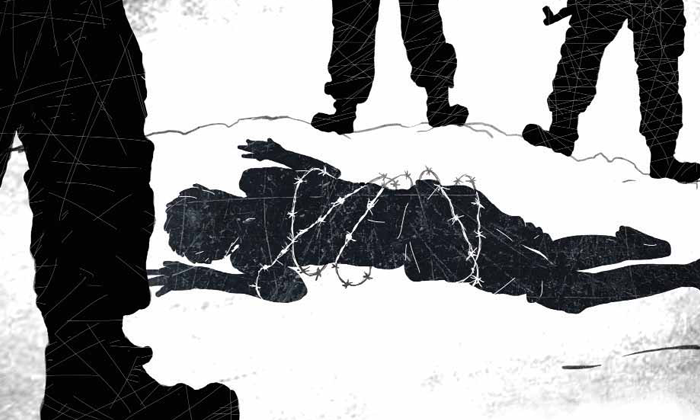Years ago, in wake of the India-Pakistan partition, Saadat Hasan Manto penned down the story of Bishen Singh— a man from the village of Toba Tek Singh— who lived in a lunatic asylum, and was being taken to the border as part of the plan to exchange lunatics – Hindus to India and Muslims to Pakistan. At the no-man’s land between the two barbed wires, Bishen Singh refuses to budge and drops dead, after uttering the words, “This is Toba Tek Singh.” Manto’s Toba Tek Singh is not any piece of fiction, it is an abiding reality, existing not just as a surreal village— now in Pakistan— but in at least two major ways.
One, the constituency of peace, built by earnest and painstaking efforts of years by countless activists on either side of the border, pressurizing establishments in New Delhi and Islamabad to foster better relations and resolve all by-standing disputes including Kashmir. Second, the people who live bang on the borders, especially at the fragile Line of Control, a contentious line dividing Jammu and Kashmir into Indian and Pakistani administered territories. Both stand threatened by the renewed tensions at the Line of Control ever since New Year.
The trouble seems to have begun on January 6 when 2 Pakistani soldiers were killed in Uri sector of LoC. Pakistan blamed the Indian army for infiltrating its territory and killing two men, a charge denied by India. The incident wasn’t quite an aberration. There have been incidents of ceasefire violation ever since the two countries agreed on a truce at the borders in 2003, more in the last one year with over 100 such cases, sometimes resulting in casualties on either side. Two days after the killing of Pakistani soldiers, Indian army accused Pakistan of killing two Indian soldiers and mutilating their bodies in Poonch sector, an allegation Pakistan denied, saying that it was the handiwork of ‘non-state actors’. Firing and shelling was on continuously for a week in this sector with Pakistan announcing the killing of yet another Pakistani soldier and injuries to civilians. At the same time, the Indian electronic media went on war mongering, provoking Indian leaders into an outrage; the likes of Arnab Goswami are thriving on the situation. While a BJP parliamentarian called for slaying 10 Pakistani heads for 2, the Indian prime minister belatedly announced that there could be ‘no usual business with Pakistan’ in such an atmosphere. The Army chief assured of a befitting reply and Gen. Parnaik, heading the Northern Command, avowed to avenge the deaths of Indian soldiers even as he allayed fears of war. On January 17, things finally calmed down a bit with a truce followed by military commanders from India and Pakistan call for restraint and order that ceasefire be maintained at all costs.
“What good is a military doctrine that derives its inspiration from the idea of revenge.”
A report in the Hindu pointed out that it may have been the flight of a septuagenarian woman from Uri sector to Pakistan administered Kashmir, to meet her family separated by the LoC that provoked security concerns of the Indian army and finally spurred the first attack. Was that really the case? Were the Uri and Poonch incidents connected, the latter being a case of probable retaliation or was it a doing of some militant groups? The answer is immaterial. Skirmishes in a war zone are often sparked by something trivial, exacerbated by insecurities, fears or sometimes plain mischief but tragically ending up in massive collateral damage, besides having the potential to trigger a major war. And that is why, even as they appear to be frivolous and small in scale, they wreak havoc in the region, causing direct damage to the people living at the borders.
Killings and mutilation of bodies of soldiers or civilians are unacceptable, but there is need to desist from a kind of chauvinism fueled by misplaced righteousness. Mutilation of bodies is internationally unacceptable and both Indian and Pakistani armies, as a matter of policy and ethics, would not recommend such barbarities. However, it is a practice that has been followed by both, even if more by Pakistan as per statistics. Bodies of slain militants have long been held like trophies and splashed in the media by gallant soldiers in their jackboots, holding their guns aloft. The Kargil war that made Barkha Dutt an overnight celebrity, showed the brutalities of the Pakistan army on television. Much later, the same journalist confessed in an article to witnessing the beheading of a Pakistani soldier and the head being held like a trophy, much to her horror. If such brutalities have to be challenged, they must be on both sides.
And what good is a military doctrine that derives its inspiration from the idea of revenge. One can understand strategic insecurities, howsoever misplaced and propelled by an unfair sense of paranoia, but the vocabulary of revenge, as reportedly used by the GOC Northern Command is something that betrays the mindset of treating the army and the people on the other side as an ‘enemy’ – an attitude mutually shared by the two militaries. Military wisdom may not always lie in retaliation and revenge but in diplomatic ways of sorting out.
Even as things brighten up with the toning down of rhetoric and two days of truce, the damage has already been done – by hasty decisions like snapping sporting ties, delaying relaxation of visa regimes and visa on arrival to senior citizens and stopping of the cross-LoC bus service and symbolic trade via the Poonch-Rawlakote between the two Kashmirs. While uncertainty still looms over the fate of these CBMs, the worst thing is the panic it has evoked, having brought the realisation that ceasefire is fragile, which is so vital a confidence building measure for propelling the peace process and also to ensure some kind of a normal life for the people living at the LoC, who have never tasted it in the last six decades.
Borders in Jammu and Kashmir, including the more complex and controversial Line of Control are areas where villages have been sliced and families divided. They are zones that resonate with stories of pain, suffering, separation, displacement and longing; excessive militarisation has been woven into that tapestry of trauma and daily life. It gives people a sense of both protection and alarm, the army donning the role of both a giver to a population that is deprived and marginalised as well as an oppressor with ordinary civilians caught in between as suspects, informers and spies – things that they have little control over. Wars and skirmishes do not only trigger homelessness, they also leave them exposed to greater repression. One decade of ceasefire means much more to them. It’s their little Toba Tek Singh, a space of respite caught between barbed wires.


